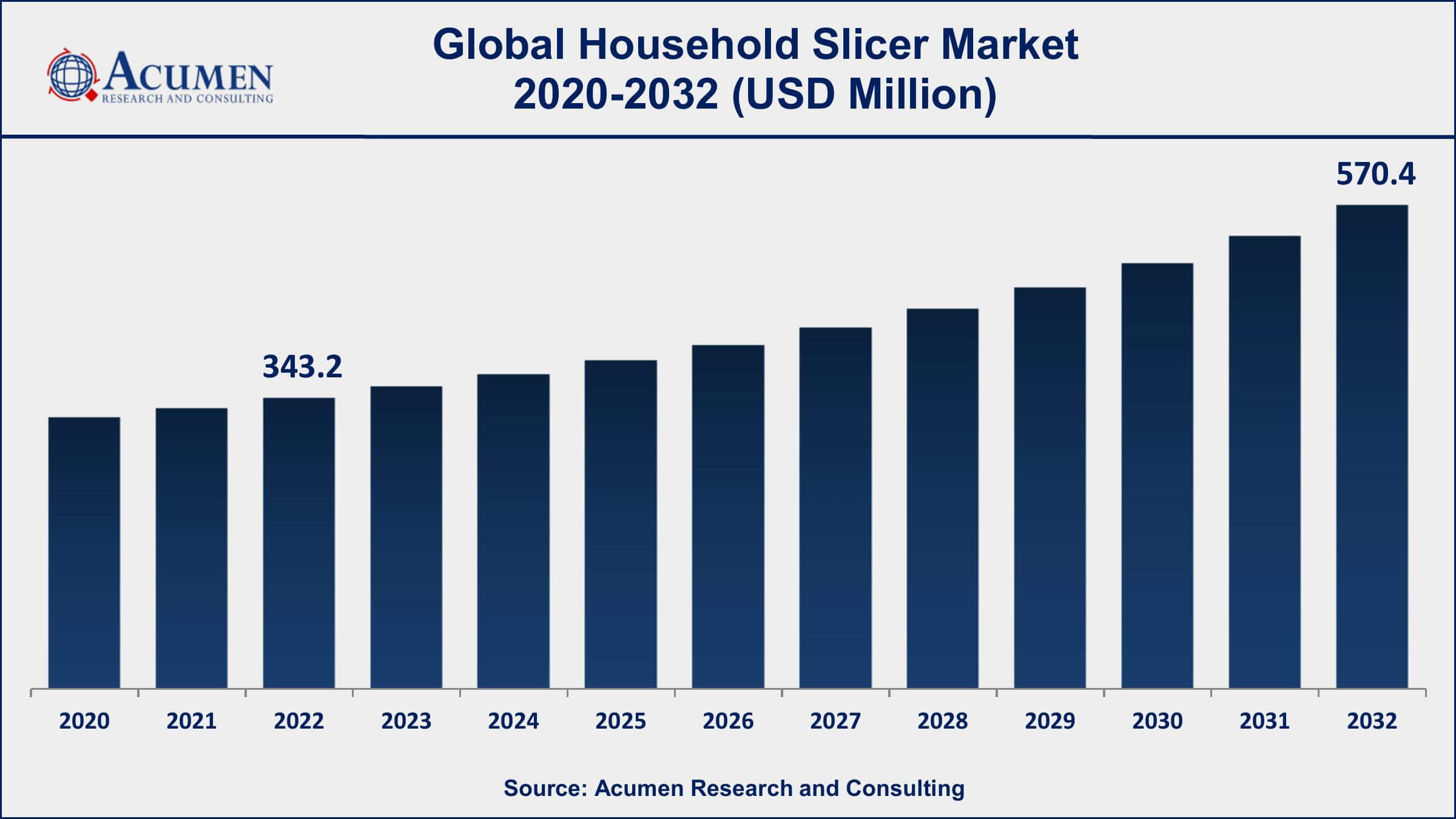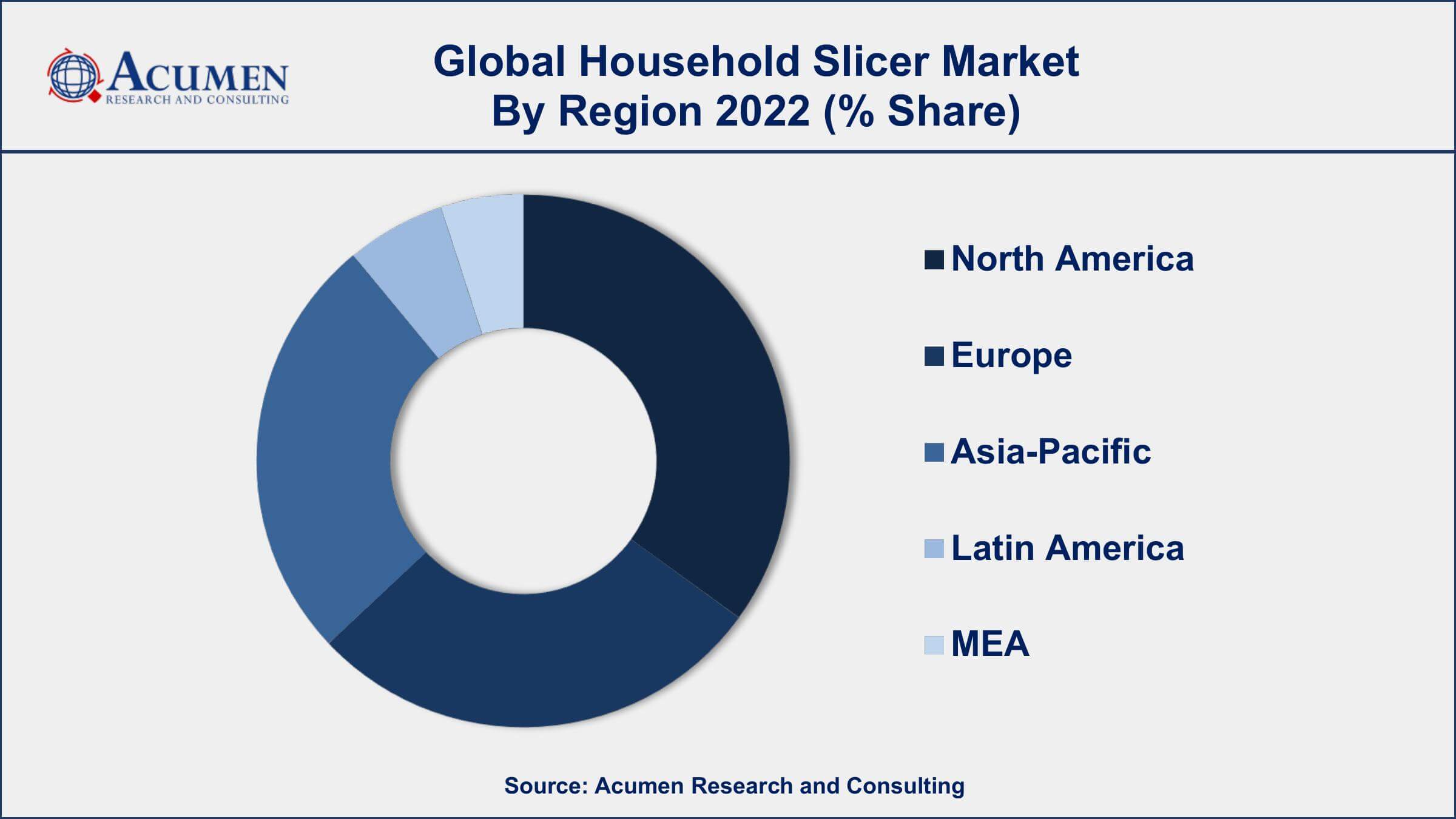April 2021
Household Slicer Market Size accounted for USD 343.2 Million in 2022 and is projected to achieve a market size of USD 570.4 Million by 2032 growing at a CAGR of 5.4% from 2023 to 2032.
The Global Household Slicer Market Size accounted for USD 343.2 Million in 2022 and is projected to achieve a market size of USD 570.4 Million by 2032 growing at a CAGR of 5.4% from 2023 to 2032.
Household Slicer Market Highlights

A household slicer, also known as a food slicer or kitchen slicer, is a kitchen appliance designed to slice various food items with precision and consistency. These devices are commonly used to slice vegetables, fruits, meats, cheeses, and bread, making meal preparation more efficient and convenient for home cooks. Household slicers come in various types, including manual slicers with adjustable blades and electric slicers that automate the slicing process. They offer versatility in the thickness of slices, allowing users to achieve the desired thickness for their culinary creations. The market for household slicers has seen growth due to the increasing emphasis on home cooking, the demand for time-saving kitchen appliances, and the desire for restaurant-quality results at home.
Over the past few years, the household slicer market has experienced steady growth, driven by several key factors. The trend of home cooking, especially during the COVID-19 pandemic, has led consumers to invest in kitchen appliances that enhance their culinary experiences. Household slicers are valued for their ability to save time in food preparation, which aligns with the busy lifestyles of many consumers. Additionally, the growth of health-conscious eating habits has increased the demand for sliced vegetables and lean meats, further boosting the market for these appliances. As technology advances, household slicers are becoming more user-friendly and multifunctional, attracting a wider consumer base. The market is also witnessing a surge in online sales channels, offering consumers easy access to a variety of slicer options.

Global Household Slicer Market Trends
Market Drivers
Market Restraints
Market Opportunities
Household Slicer Market Report Coverage
| Market | Household Slicer Market |
| Household Slicer Market Size 2022 | USD 343.2 Million |
| Household Slicer Market Forecast 2032 | USD 570.4 Million |
| Household Slicer Market CAGR During 2023 - 2032 | 5.4% |
| Household Slicer Market Analysis Period | 2020 - 2032 |
| Household Slicer Market Base Year |
2022 |
| Household Slicer Market Forecast Data | 2023 - 2032 |
| Segments Covered | By Product, By Distribution Channel, And By Geography |
| Regional Scope | North America, Europe, Asia Pacific, Latin America, and Middle East & Africa |
| Key Companies Profiled | Breville Group Limited, Cuisinart (a brand of Conair Corporation), Hamilton Beach Brands, Inc., OXO (a brand of Helen of Troy Limited), KitchenAid (a brand of Whirlpool Corporation), Weston Brands LLC, Chef's Choice (a brand of EdgeCraft Corporation), Benriner (a brand of Benriner USA), Swissmar (a brand of Swissmar Inc.), and Bron Coucke (a brand of Bron-Coucke SAS) |
| Report Coverage |
Market Trends, Drivers, Restraints, Competitive Analysis, Player Profiling, Covid-19 Analysis, Regulation Analysis |
A household slicer is a versatile kitchen appliance designed for slicing and cutting various food items with precision and ease. It typically consists of a sharp blade or a set of blades and an adjustable thickness control mechanism. These slicers are primarily used to achieve consistent and uniform slices of fruits, vegetables, meats, cheeses, and more. They are available in manual and electric versions, each offering its own set of advantages.
The application of household slicers in the kitchen is multifaceted. They play a crucial role in food preparation, making it quicker and more efficient. Home cooks and chefs alike use these slicers to create beautifully presented dishes, such as salads with perfectly sliced cucumbers, thinly sliced meats for sandwiches, or even delicate carpaccio. In addition to aesthetics, household slicers help control portion sizes and ensure that ingredients are sliced evenly, which can be important for both cooking and food presentation. These appliances are also valued for their ability to save time, especially when handling large quantities of food, and they are particularly useful for those who enjoy experimenting with different culinary techniques.
The household slicer market has witnessed significant growth in recent years, driven by several key factors. One of the primary drivers is the increasing demand for time-saving kitchen appliances in modern households. With busy lifestyles and a greater emphasis on convenience, consumers are looking for tools that can expedite food preparation processes. Household slicers, equipped with sharp blades and adjustable settings, enable users to quickly and uniformly slice a variety of food items, from vegetables to meats and cheeses. This convenience factor has contributed to the sustained growth of the household slicer market. Another major driver is the rising interest in healthy and homemade food. As health-conscious consumers seek to control the ingredients and quality of their meals, household slicers have become invaluable tools for creating fresh and nutritious dishes.
Household Slicer Market Segmentation
The global household slicers market segmentation is based on product, distribution channel, and geography.
Household Slicer Market By Product
In terms of products, the manual segment accounted for the largest market share in 2022. One of the primary drivers is the increasing interest in traditional and artisanal food preparation methods. Many consumers, especially cooking enthusiasts and those passionate about preserving food, prefer manual slicers for their precision and control. Manual slicers allow users to adjust slicing thickness with a hand-crank mechanism or by manually guiding the food, resulting in uniform and customized cuts. This appeal to craftsmanship and customization has contributed to the growth of the manual slicer segment. Another significant factor fueling the growth of manual slicers is the demand for eco-friendly and sustainable kitchen appliances. Manual slicers are often simpler in design, with fewer electronic components, making them more energy-efficient and environmentally friendly compared to their electric counterparts.
Household Slicer Market By Distribution Channel
According to the household slicer market forecast, the online segment is expected to witness significant growth in the coming years. One of the primary drivers behind this growth is the increasing preference among consumers for online shopping. The convenience of browsing and purchasing household slicers from the comfort of one's home, along with the availability of a wide range of options and competitive pricing, has made online channels the go-to choice for many buyers. Additionally, the COVID-19 pandemic further accelerated the shift to online shopping, as people sought contactless and safe ways to acquire kitchen appliances, including slicers. Moreover, the online segment offers a platform for consumers to access user reviews, ratings, and detailed product information, aiding them in making informed purchasing decisions. This transparency and the ability to compare different slicer models have enhanced consumer confidence in buying slicers online.
Household Slicer Market Regional Outlook
North America
Europe
Asia-Pacific
Latin America
The Middle East & Africa

Household Slicer Market Regional Analysis
North America's domination of the household slicer market can be attributed to several key factors that have collectively contributed to its strong position in the industry. First and foremost, North America boasts a large and affluent consumer base with a strong appetite for kitchen appliances that simplify food preparation. The region's culturally diverse culinary landscape, along with a growing emphasis on home-cooked meals and healthier eating habits, has fueled demand for household slicers. Additionally, North America is home to several major household appliance manufacturers and brands that have a strong presence in the global market. These companies have leveraged their expertise in innovation and marketing to develop and promote household slicers tailored to the preferences and needs of North American consumers. Their wide distribution networks and effective marketing strategies have enabled them to capture a significant share of the domestic market. Moreover, the rise of e-commerce and the convenience of online shopping have played a pivotal role in North America's household slicer market growth.
Household Slicer Market Player
Some of the top household slicer market companies offered in the professional report include Breville Group Limited, Cuisinart (a brand of Conair Corporation), Hamilton Beach Brands, Inc., OXO (a brand of Helen of Troy Limited), KitchenAid (a brand of Whirlpool Corporation), Weston Brands LLC, Chef's Choice (a brand of EdgeCraft Corporation), Benriner (a brand of Benriner USA), Swissmar (a brand of Swissmar Inc.), and Bron Coucke (a brand of Bron-Coucke SAS).
Looking for discounts, bulk pricing, or custom solutions? Contact us today at sales@acumenresearchandconsulting.com
April 2021
November 2020
January 2020
July 2024